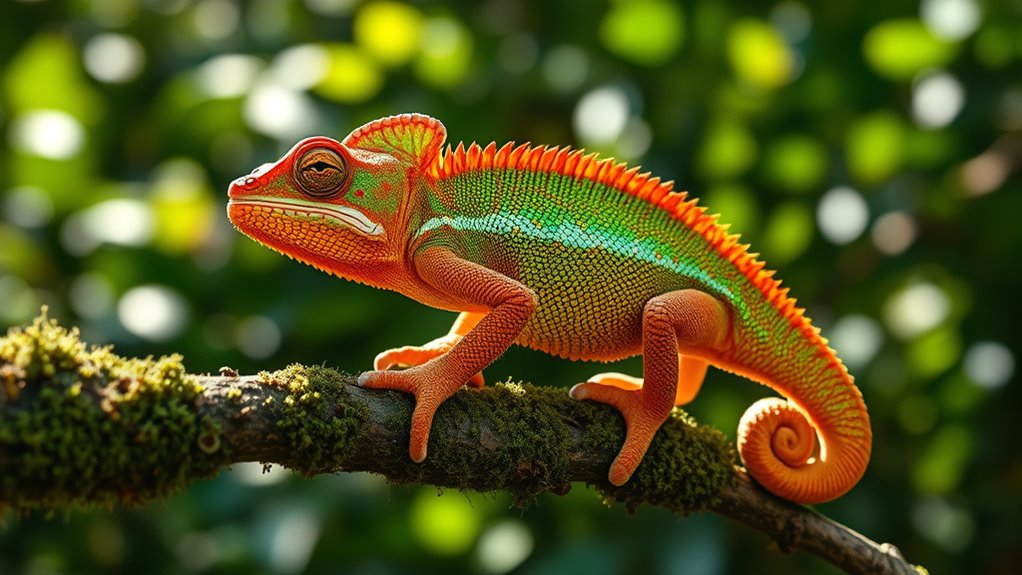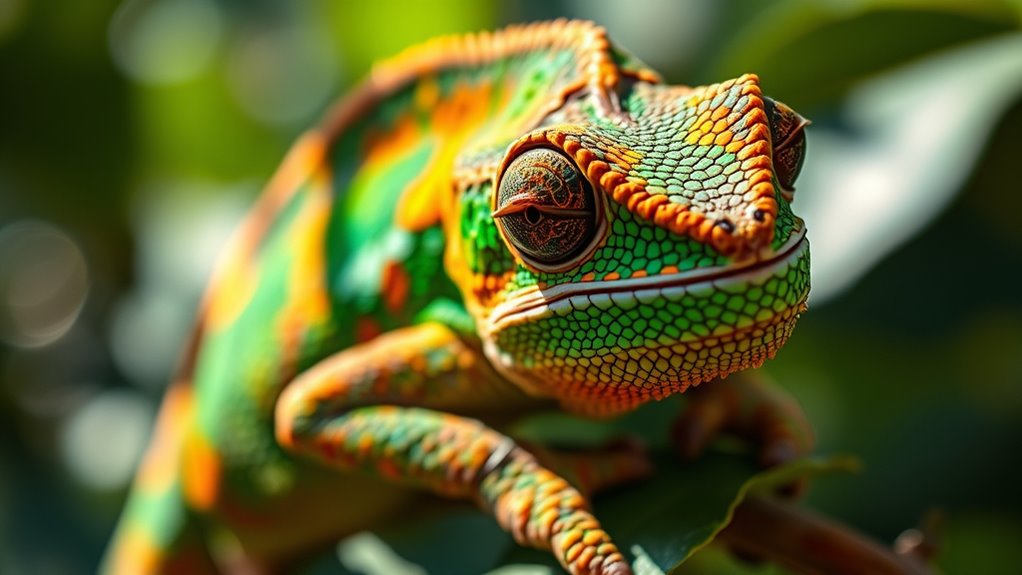Chameleons are incredible at adapting their colors to match changing light conditions, helping them hide, communicate, and manage their temperature. They use specialized skin cells called chromatophores that expand or contract pigments, allowing quick color shifts. Whether blending into green foliage or shifting to duller shades in shaded areas, they master environmental cues for survival. Keep exploring to discover how their remarkable biological abilities make them true masters of camouflage and communication.
Key Takeaways
- Chameleons adjust their colors to blend seamlessly with varying light and surroundings for effective camouflage.
- Specialized skin cells called chromatophores enable rapid and reversible color changes in response to environmental cues.
- Bright hues appear in sunlight, while duller shades help in shaded areas, aiding in concealment and temperature regulation.
- Color shifts reflect internal states like stress or readiness to mate, signaling to other chameleons.
- Structural skin changes manipulate light reflection, allowing quick shimmering or shifting colors in changing light conditions.

Chameleons are renowned for their incredible ability to change colors, a feature that often surprises those who observe them. This remarkable skill isn’t just for show; it serves essential functions such as communication, temperature regulation, and, most notably, camouflage. When you watch a chameleon shift its hues, you’re witnessing sophisticated camouflage techniques in action. These animals utilize their color adaptation mechanisms to blend seamlessly into their surroundings, making it harder for predators to spot them. Their ability to adapt their appearance is a blend of complex biological processes that respond to environmental cues and internal states.
Chameleons change colors for communication, temperature, and camouflage, blending seamlessly to survive and thrive in diverse environments.
Your first impression might be that chameleons change color solely to match their environment, but it’s more nuanced. They use their color-changing abilities as a form of visual signaling—indicating stress, dominance, or readiness to mate. When a chameleon feels threatened or wants to assert dominance, it might darken or display bold patterns. Conversely, during calm or submissive states, it might adopt softer hues. These color shifts are driven by specialized skin cells called chromatophores, which contain different pigments. By expanding or contracting these cells, the chameleon can manipulate its coloration rapidly.
The camouflage techniques employed by chameleons involve a sophisticated interplay between their skin’s physical properties and the environment. When blending into foliage or bark, they adjust their colors to match shades of green, brown, or even gray. This color adaptation mechanism is so finely tuned that it allows them to become nearly invisible in their habitat. You might notice that the intensity and pattern of their color change depend on factors like light, temperature, and mood. For example, in bright sunlight, they often display vibrant hues, while in shaded areas, their colors might become duller to avoid detection.
Additionally, their ability to change color quickly is linked to their capacity for vibrational energy regulation, which influences how they respond to environmental stimuli and internal states. This ability to adapt quickly is a survival advantage, helping them ambush prey or escape predators. The dynamic process involves not only the pigment cells but also structural changes in the skin that reflect light differently. As a result, a chameleon can appear to shimmer or shift colors almost instantaneously. This versatility in color change demonstrates an evolutionary mastery of camouflage techniques, allowing these creatures to thrive in diverse environments. When you observe a chameleon in action, you’re witnessing nature’s own masterclass in visual disguise—an elegant, adaptive response to ever-changing light and surroundings.
Frequently Asked Questions
How Do Chameleons Perceive Color Changes?
You perceive chameleon color changes through complex neural mechanisms that interpret signals from pigment cell interactions in their skin. When they detect environmental cues, their brains send signals to adjust the pigments within chromatophores, resulting in rapid color shifts. These neural responses enable chameleons to blend in, communicate, or regulate temperature. Your understanding of this process highlights how their sensory and neural systems cooperate to produce the remarkable color versatility you observe.
Can Chameleon Colors Indicate Their Mood or Health?
Yes, chameleon colors can indicate their mood or health. You’ll notice color symbolism where vibrant hues often show alertness or aggression, while duller shades may signal stress or illness. Ecological significance also plays a role, as color changes help with camouflage or attracting mates. By observing these shifts, you can gauge their emotional state and physical well-being, gaining insights into their behavior and environment.
Are Chameleon Color Changes Purely for Camouflage?
You might think chameleons change colors solely for camouflage, but their color shifts serve multiple purposes. These changes are essential camouflage strategies, aiding predator evasion and communication. During territorial disputes or to display readiness to mate, they alter hues. This adaptability not only helps them blend into surroundings but also signals mood and health, making their color changes a complex, multifunctional tool rather than just a simple disguise.
How Quickly Can a Chameleon Change Its Color?
You might be surprised, but a chameleon can change its color in just about 30 seconds to a few minutes. The speed of this color change depends on environmental triggers like light, temperature, and mood. When you notice a chameleon shifting hues, it’s actively responding to its surroundings, either for camouflage, communication, or temperature regulation. So, their color change speed is quite impressive and adaptive to different situations.
Do All Chameleon Species Have the Same Color-Changing Abilities?
You might think every chameleon can transform into a rainbow, but their color-changing abilities aren’t the same. Some species boast advanced chromatophore structures and dynamic pigment distribution, allowing rapid, vibrant shifts, while others have limited color ranges. This diversity means not all chameleons are masters of disguise or display. Instead, their abilities vary greatly, making each species uniquely fascinating in how they adapt and communicate through color.
Conclusion
Just like a chameleon blending into its surroundings, you hold the power to adapt and shine in any light. Embrace the versatility of these colors, and you’ll find yourself maneuvering life’s changing scenes with ease and confidence. Remember, as the chameleon teaches us, true strength lies in flexibility and transformation. So, stay curious, keep evolving, and let your colors shift beautifully with every new day.









